英语语音课程教案
- 格式:doc
- 大小:82.50 KB
- 文档页数:17
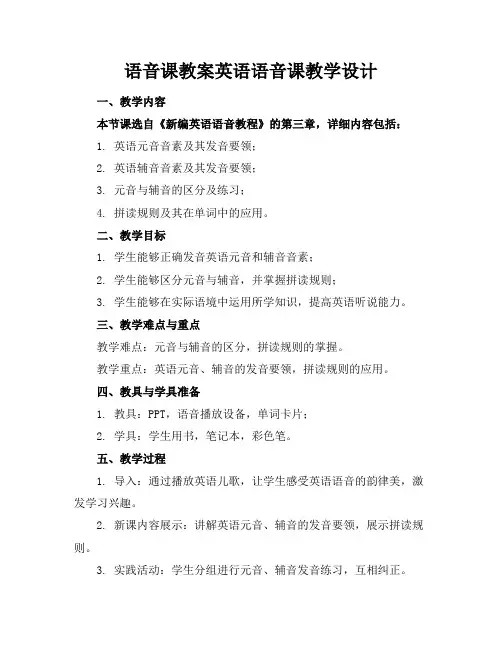
语音课教案英语语音课教学设计一、教学内容本节课选自《新编英语语音教程》的第三章,详细内容包括:1. 英语元音音素及其发音要领;2. 英语辅音音素及其发音要领;3. 元音与辅音的区分及练习;4. 拼读规则及其在单词中的应用。
二、教学目标1. 学生能够正确发音英语元音和辅音音素;2. 学生能够区分元音与辅音,并掌握拼读规则;3. 学生能够在实际语境中运用所学知识,提高英语听说能力。
三、教学难点与重点教学难点:元音与辅音的区分,拼读规则的掌握。
教学重点:英语元音、辅音的发音要领,拼读规则的应用。
四、教具与学具准备1. 教具:PPT,语音播放设备,单词卡片;2. 学具:学生用书,笔记本,彩色笔。
五、教学过程1. 导入:通过播放英语儿歌,让学生感受英语语音的韵律美,激发学习兴趣。
2. 新课内容展示:讲解英语元音、辅音的发音要领,展示拼读规则。
3. 实践活动:学生分组进行元音、辅音发音练习,互相纠正。
4. 例题讲解:分析单词拼写与发音的关系,引导学生运用拼读规则。
5. 随堂练习:让学生朗读单词,巩固所学知识。
6. 小组讨论:讨论拼读规则在实际应用中的注意事项。
六、板书设计1. 英语元音、辅音音素表;2. 拼读规则;3. 课堂练习单词。
七、作业设计1. 作业题目:(1)朗读课文,录音自评;(2)根据拼读规则,拼写给定单词;(3)用所学语音知识,编写一段对话。
2. 答案:(1)见课文;(2)见课后单词表;(3)略。
八、课后反思及拓展延伸1. 反思:关注学生在课堂上的发音问题,及时进行个性化指导。
2. 拓展延伸:鼓励学生在课后观看英语原声电影,模仿地道发音,提高听说能力。
同时,推荐相关语音学习资料,帮助学生巩固所学知识。
重点和难点解析1. 教学难点:元音与辅音的区分,拼读规则的掌握。
2. 实践活动:学生分组进行元音、辅音发音练习,互相纠正。
3. 例题讲解:分析单词拼写与发音的关系,引导学生运用拼读规则。
4. 作业设计:根据拼读规则,拼写给定单词。
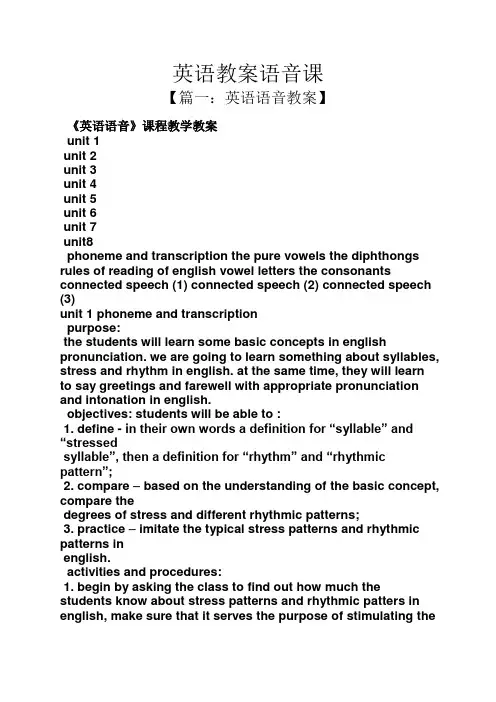
英语教案语音课【篇一:英语语音教案】《英语语音》课程教学教案unit 1unit 2unit 3unit 4unit 5unit 6unit 7unit8phoneme and transcription the pure vowels the diphthongs rules of reading of english vowel letters the consonants connected speech (1) connected speech (2) connected speech (3)unit 1 phoneme and transcriptionpurpose:the students will learn some basic concepts in english pronunciation. we are going to learn something about syllables, stress and rhythm in english. at the same time, they will learnto say greetings and farewell with appropriate pronunciation and intonation in english.objectives: students will be able to :1. define - in their own words a definition for “syllable” and “stressedsyllable”, then a definition for “rhythm” and “rhythmic pattern”;2. compare – based on the understanding of the basic concept, compare thedegrees of stress and different rhythmic patterns;3. practice – imitate the typical stress patterns and rhythmic patterns inenglish.activities and procedures:1. begin by asking the class to find out how much thestudents know about stress patterns and rhythmic patters in english, make sure that it serves the purpose of stimulating thestudents to think about the issue and have the desire to find out the answers themselves.2. display examples by playing the recording of the native speakers showing the typical stress patters and rhythmic patterns in english.3. ask the students to listen to the tapes to mark out the stressed syllables in words.4. ask the students to listen to the tapes to mark out the stressed words in sentences.5. have the students imitate the stress patterns and rhythmic patterns to experience the rhythm in speech.6. have the students share what they have learned by reading out the practice materials in pairs.7. have the students listen to the conversations recorded by native speakers of english and try to get the rhythmic patterns in their speech.8. have the students practice the guided conversation. ask them to pay special attention to the stress the rhythm in speech.9. highlight the language function in the conversation in the practice.10. have several pairs of the students present their conversation in the class.11. comment on the students? performance by highlighting the achievement of the students and the efforts they need for the improvement.12. ask the students to do more practice after class and get ready for presentation during the next session.basic concepts: syllables, stress rhythmin this unit, we are going to learn some basic concepts in english pronunciation. we are going to learn something about syllables, stress and rhythm in english. at thesame time, we are going to learn to say greetings and farewell with appropriate pronunciation and intonation in english.first of all, let?s look at the syllable in english.please listen to the following word: driveway.now, tell me, how many syllables there are in this word? right. there are two. please listen to the following sentence: drive him away.tell me, how many syllables there are in this sentence? right. there are four.introductionso. what is a syllable?a syllable is a word part and the basic unit of english rhythm. english words can have one, two, three or even more syllables. in the word ?driveway?, there are two syllables. in the sentence ?drive him away?, there are four.what is a stressed syllable?in english words with more than one syllable, one of them will receive more stress than the others. stressed syllables are those that are marked in the dictionary as stressed. for example, in the word ?driveway?, the first syllable is a stressed syllable while the second syllable is not.stressed syllables in english are usually longer, louder, and higher in pitch. listen to the following example:syllable 1 syllable 2 (short) (long)syllable 3(short)the word banana has 3 syllables. syllable 1 is not stressed and so is short. syllable 2 is stressed and so is long with a clear vowel sound / :/. syllable 3 is not stressed and so is also short. here is a short summary about the stressed and unstressed syllables:stressed syllables are strong syllables. unstressed syllables are weak syllables. stressed syllables:- are long- have a pitch change- have full vowel sounds.unstressed syllables:- are short- often have a reduced vowel sound.now let?s look at the rhythm in english.we all know that correct pronunciation of the individual english sounds is important in communication. the way the sounds are organized, however, is often more crucial for understanding. the rhythm of english, for example, is one of the two major organizing structures that native speakers rely on to process speech.what is rhythm?rhythm can be found everywhere in life: the sound of a clock, the beating of the heart, the strokes of a swimmer, and ofcourse in poetry and music. but rhythm in language is less familiar because it is less obvious. the rhythm of a language is characterized by the timing pattern of successive syllables. in some languages, every syllable is given about the same length, while in others, syllables vary in length. in english, strongbeats are called stress -- the heart of the rhythmic pattern.音节、重音与节奏本单元将向大家介绍英语语音语调的基本概念, 主要介绍英语语音的音节、重音和节奏规律。
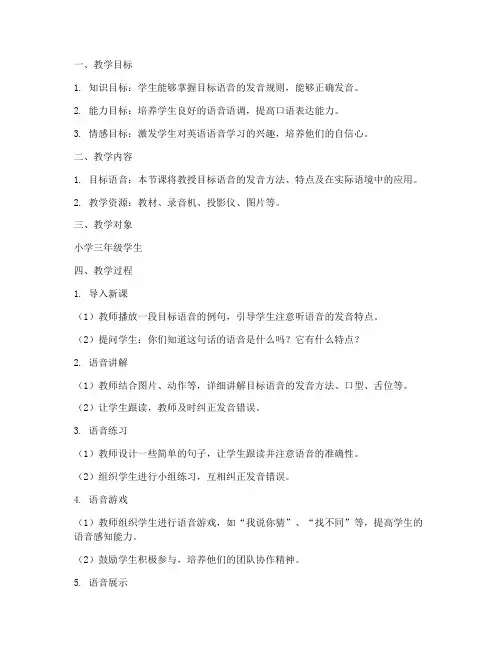
一、教学目标1. 知识目标:学生能够掌握目标语音的发音规则,能够正确发音。
2. 能力目标:培养学生良好的语音语调,提高口语表达能力。
3. 情感目标:激发学生对英语语音学习的兴趣,培养他们的自信心。
二、教学内容1. 目标语音:本节课将教授目标语音的发音方法、特点及在实际语境中的应用。
2. 教学资源:教材、录音机、投影仪、图片等。
三、教学对象小学三年级学生四、教学过程1. 导入新课(1)教师播放一段目标语音的例句,引导学生注意听语音的发音特点。
(2)提问学生:你们知道这句话的语音是什么吗?它有什么特点?2. 语音讲解(1)教师结合图片、动作等,详细讲解目标语音的发音方法、口型、舌位等。
(2)让学生跟读,教师及时纠正发音错误。
3. 语音练习(1)教师设计一些简单的句子,让学生跟读并注意语音的准确性。
(2)组织学生进行小组练习,互相纠正发音错误。
4. 语音游戏(1)教师组织学生进行语音游戏,如“我说你猜”、“找不同”等,提高学生的语音感知能力。
(2)鼓励学生积极参与,培养他们的团队协作精神。
5. 语音展示(1)请部分学生展示自己学到的语音,教师给予评价和指导。
(2)鼓励学生勇敢展示,增强他们的自信心。
6. 总结与反思(1)教师对本节课的教学内容进行总结,强调重点和难点。
(2)引导学生反思自己在学习过程中的收获和不足,提出改进措施。
五、教学评价1. 学生对目标语音的掌握程度。
2. 学生在课堂上的参与度、积极性。
3. 学生在语音游戏和展示环节的表现。
六、教学反思1. 教师在教学过程中是否关注学生的个体差异,给予针对性的指导。
2. 教学方法是否有效,是否激发了学生的学习兴趣。
3. 教学过程中是否注重学生的语音感知和口语表达能力的培养。
通过以上教学过程,相信学生能够掌握目标语音的发音方法,提高英语口语表达能力,为今后的英语学习打下坚实的基础。
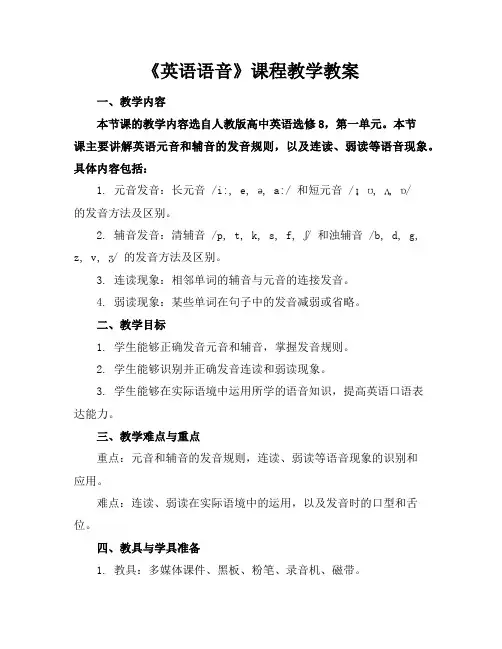
《英语语音》课程教学教案一、教学内容本节课的教学内容选自人教版高中英语选修8,第一单元。
本节课主要讲解英语元音和辅音的发音规则,以及连读、弱读等语音现象。
具体内容包括:1. 元音发音:长元音 /i:, e, ə, a:/ 和短元音 /ɪ, ʊ, ʌ, ɒ/的发音方法及区别。
2. 辅音发音:清辅音 /p, t, k, s, f, ʃ/ 和浊辅音 /b, d, g, z, v, ʒ/ 的发音方法及区别。
3. 连读现象:相邻单词的辅音与元音的连接发音。
4. 弱读现象:某些单词在句子中的发音减弱或省略。
二、教学目标1. 学生能够正确发音元音和辅音,掌握发音规则。
2. 学生能够识别并正确发音连读和弱读现象。
3. 学生能够在实际语境中运用所学的语音知识,提高英语口语表达能力。
三、教学难点与重点重点:元音和辅音的发音规则,连读、弱读等语音现象的识别和应用。
难点:连读、弱读在实际语境中的运用,以及发音时的口型和舌位。
四、教具与学具准备1. 教具:多媒体课件、黑板、粉笔、录音机、磁带。
2. 学具:课本、练习册、录音机、磁带。
五、教学过程1. 引入:通过播放一段英语对话,让学生注意到的语音现象,激发学生学习兴趣。
2. 讲解:讲解元音和辅音的发音规则,以及连读、弱读等语音现象,示例讲解,让学生跟着老师一起发音。
3. 练习:学生跟读课文,模仿发音,教师逐一纠正发音错误。
4. 应用:学生分组进行角色扮演,运用所学的语音知识进行对话,教师巡回指导。
六、板书设计1. 元音发音规则:长元音 /i:, e, ə, a:/短元音 /ɪ, ʊ, ʌ, ɒ/2. 辅音发音规则:清辅音 /p, t, k, s, f, ʃ/浊辅音 /b, d, g, z, v, ʒ/3. 连读现象:相邻单词的辅音与元音的连接发音。
4. 弱读现象:某些单词在句子中的发音减弱或省略。
七、作业设计1. 作业题目:(1) 模仿课本对话,注意连读、弱读的发音。
(2) 找出身边的英语语音例子,分析其发音规则。
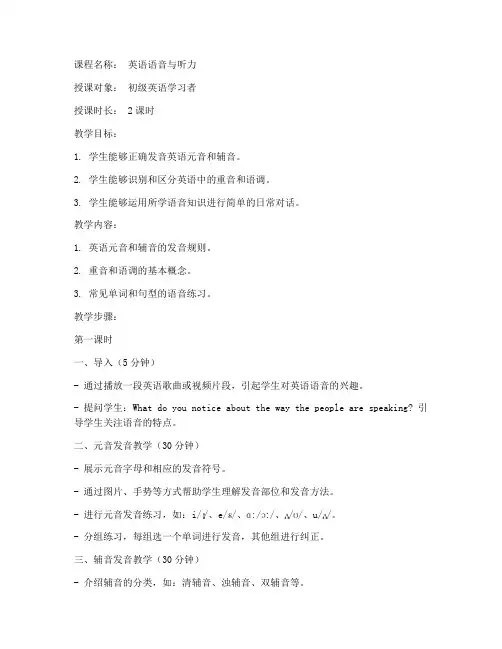
课程名称:英语语音与听力授课对象:初级英语学习者授课时长: 2课时教学目标:1. 学生能够正确发音英语元音和辅音。
2. 学生能够识别和区分英语中的重音和语调。
3. 学生能够运用所学语音知识进行简单的日常对话。
教学内容:1. 英语元音和辅音的发音规则。
2. 重音和语调的基本概念。
3. 常见单词和句型的语音练习。
教学步骤:第一课时一、导入(5分钟)- 通过播放一段英语歌曲或视频片段,引起学生对英语语音的兴趣。
- 提问学生:What do you notice about the way the people are speaking? 引导学生关注语音的特点。
二、元音发音教学(30分钟)- 展示元音字母和相应的发音符号。
- 通过图片、手势等方式帮助学生理解发音部位和发音方法。
- 进行元音发音练习,如:i/ɪ/、e/ɛ/、ɑ:/ɔ:/、ʌ/ʊ/、u/ʌ/。
- 分组练习,每组选一个单词进行发音,其他组进行纠正。
三、辅音发音教学(30分钟)- 介绍辅音的分类,如:清辅音、浊辅音、双辅音等。
- 通过发音示范和练习,让学生掌握不同辅音的发音。
- 练习辅音组合的发音,如:st, nd, rd, th等。
四、总结与作业(5分钟)- 总结本节课所学内容,强调重点和难点。
- 布置作业:回家后练习本节课所学的元音和辅音发音,并记录下来。
第二课时一、复习与巩固(10分钟)- 检查学生的发音练习情况,纠正错误。
- 通过游戏或竞赛形式,巩固学生对元音和辅音发音的记忆。
二、重音与语调教学(30分钟)- 介绍重音的概念,通过例子说明重音在句子中的作用。
- 讲解语调的类型,如:升调、降调、升降调等。
- 练习重音和语调的运用,如:朗读短文,注意句子中的重音和语调。
三、综合练习(20分钟)- 让学生根据所学知识,组成简单的对话。
- 鼓励学生在对话中运用重音和语调,使对话更加生动。
四、总结与反馈(5分钟)- 总结本节课所学内容,强调重音和语调的重要性。
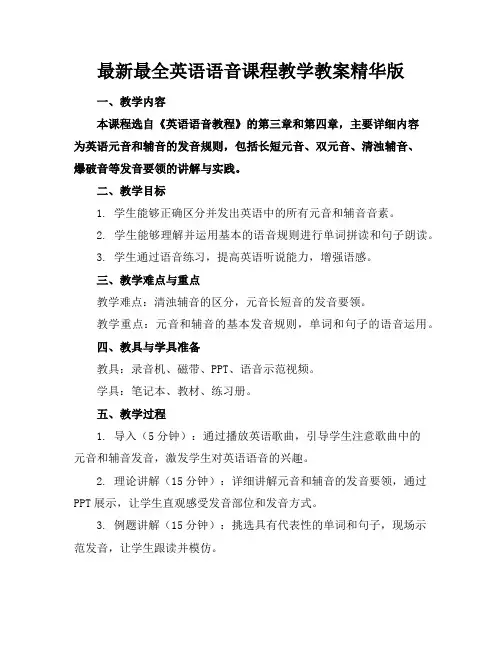
最新最全英语语音课程教学教案精华版一、教学内容本课程选自《英语语音教程》的第三章和第四章,主要详细内容为英语元音和辅音的发音规则,包括长短元音、双元音、清浊辅音、爆破音等发音要领的讲解与实践。
二、教学目标1. 学生能够正确区分并发出英语中的所有元音和辅音音素。
2. 学生能够理解并运用基本的语音规则进行单词拼读和句子朗读。
3. 学生通过语音练习,提高英语听说能力,增强语感。
三、教学难点与重点教学难点:清浊辅音的区分,元音长短音的发音要领。
教学重点:元音和辅音的基本发音规则,单词和句子的语音运用。
四、教具与学具准备教具:录音机、磁带、PPT、语音示范视频。
学具:笔记本、教材、练习册。
五、教学过程1. 导入(5分钟):通过播放英语歌曲,引导学生注意歌曲中的元音和辅音发音,激发学生对英语语音的兴趣。
2. 理论讲解(15分钟):详细讲解元音和辅音的发音要领,通过PPT展示,让学生直观感受发音部位和发音方式。
3. 例题讲解(15分钟):挑选具有代表性的单词和句子,现场示范发音,让学生跟读并模仿。
4. 随堂练习(10分钟):学生两人一组,进行元音和辅音的发音练习,相互纠正,教师巡回指导。
5. 小组活动(15分钟):分组进行单词拼读比赛,提高学生的语音运用能力。
六、板书设计1. 元音和辅音的分类及发音要领。
2. 典型单词和句子的发音示范。
3. 课堂练习及注意事项。
七、作业设计1. 作业题目:课后练习册第三章和第四章的练习题。
答案:参照教材和课堂讲解,自行完成作业。
2. 拓展作业:录制自己的英语发音视频,进行自我评价和同学互评。
八、课后反思及拓展延伸2. 拓展延伸:推荐学生参加英语语音培训课程,提高语音水平,增强英语实际运用能力。
同时,鼓励学生在日常生活中多听、多说、多模仿,提高英语语音素养。
重点和难点解析1. 清浊辅音的区分。
2. 元音长短音的发音要领。
3. 教学过程中的例题讲解和随堂练习。
4. 板书设计中的发音示范和注意事项。
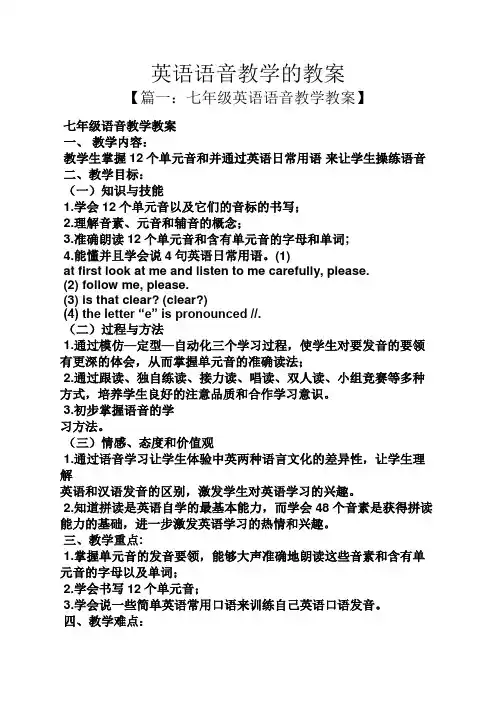
英语语音教学的教案【篇一:七年级英语语音教学教案】七年级语音教学教案一、教学内容:教学生掌握12个单元音和并通过英语日常用语来让学生操练语音二、教学目标:(一)知识与技能1.学会12个单元音以及它们的音标的书写;2.理解音素、元音和辅音的概念;3.准确朗读12个单元音和含有单元音的字母和单词;4.能懂并且学会说4句英语日常用语。
(1)at first look at me and listen to me carefully, please.(2) follow me, please.(3) is that clear? (clear?)(4) the letter “e” is pronounced //.(二)过程与方法1.通过模仿—定型—自动化三个学习过程,使学生对要发音的要领有更深的体会,从而掌握单元音的准确读法;2.通过跟读、独自练读、接力读、唱读、双人读、小组竞赛等多种方式,培养学生良好的注意品质和合作学习意识。
3.初步掌握语音的学习方法。
(三)情感、态度和价值观1.通过语音学习让学生体验中英两种语言文化的差异性,让学生理解英语和汉语发音的区别,激发学生对英语学习的兴趣。
2.知道拼读是英语自学的最基本能力,而学会48个音素是获得拼读能力的基础,进一步激发英语学习的热情和兴趣。
三、教学重点:1.掌握单元音的发音要领,能够大声准确地朗读这些音素和含有单元音的字母以及单词;2.学会书写12个单元音;3.学会说一些简单英语常用口语来训练自己英语口语发音。
四、教学难点:2.准确的朗读音标五、教学步骤:step1: organization(5’) 1. 师生问好(规范要求)。
(1) ---good afternoon.-- good afternoon.(2)—how are you today?(3)---we’re very well. thank you. and you?----i’m fine, too.2.课堂组织(1)每个同学的位置可以用两个号码来定位,即number _和row_比如??例1,2,3??问学生有什么规律? s1:排叫做row,而列叫做number,后面的数字则表示第几排或者第几列。
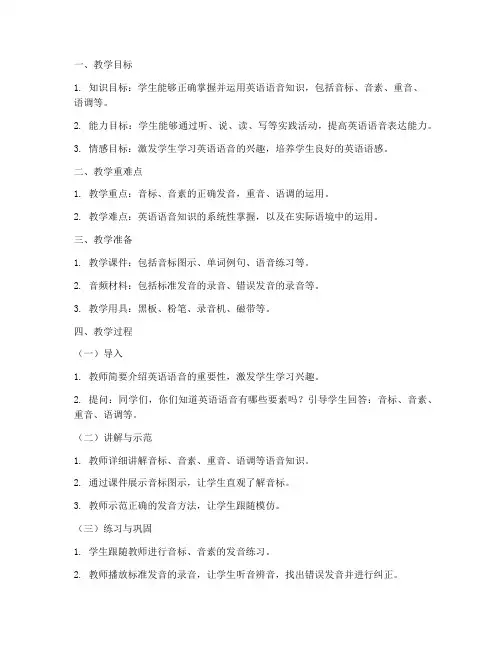
一、教学目标1. 知识目标:学生能够正确掌握并运用英语语音知识,包括音标、音素、重音、语调等。
2. 能力目标:学生能够通过听、说、读、写等实践活动,提高英语语音表达能力。
3. 情感目标:激发学生学习英语语音的兴趣,培养学生良好的英语语感。
二、教学重难点1. 教学重点:音标、音素的正确发音,重音、语调的运用。
2. 教学难点:英语语音知识的系统性掌握,以及在实际语境中的运用。
三、教学准备1. 教学课件:包括音标图示、单词例句、语音练习等。
2. 音频材料:包括标准发音的录音、错误发音的录音等。
3. 教学用具:黑板、粉笔、录音机、磁带等。
四、教学过程(一)导入1. 教师简要介绍英语语音的重要性,激发学生学习兴趣。
2. 提问:同学们,你们知道英语语音有哪些要素吗?引导学生回答:音标、音素、重音、语调等。
(二)讲解与示范1. 教师详细讲解音标、音素、重音、语调等语音知识。
2. 通过课件展示音标图示,让学生直观了解音标。
3. 教师示范正确的发音方法,让学生跟随模仿。
(三)练习与巩固1. 学生跟随教师进行音标、音素的发音练习。
2. 教师播放标准发音的录音,让学生听音辨音,找出错误发音并进行纠正。
3. 学生分组进行语音练习,互相纠正发音错误。
(四)拓展与应用1. 教师给出一些单词和句子,让学生运用所学语音知识进行朗读和翻译。
2. 学生进行角色扮演,模拟实际语境,运用语音知识进行交流。
(五)总结与反思1. 教师总结本节课所学的语音知识,强调重点和难点。
2. 学生分享自己在学习过程中的收获和体会,提出疑问和困惑。
五、课后作业1. 复习本节课所学的语音知识,巩固发音。
2. 播放英语语音教材,跟读并模仿发音。
3. 针对课后作业中的错误发音,查找原因并改正。
六、教学评价1. 课堂表现:观察学生在课堂上的参与程度、发音准确性等。
2. 课后作业:检查学生课后作业的完成情况,了解学生对语音知识的掌握程度。
3. 语音测试:定期进行语音测试,评估学生的学习成果。
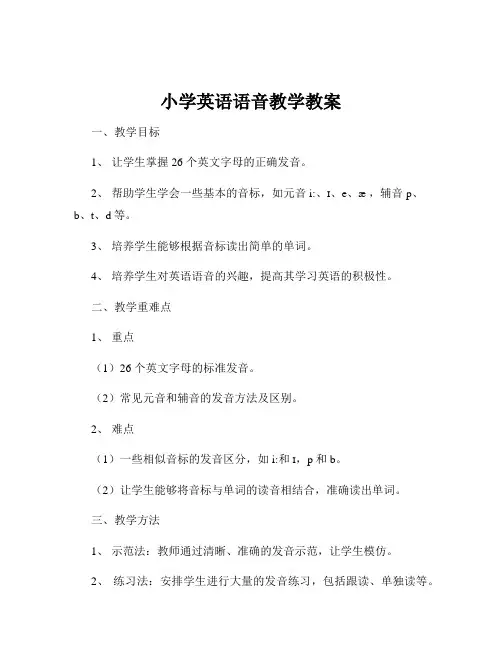
小学英语语音教学教案一、教学目标1、让学生掌握 26 个英文字母的正确发音。
2、帮助学生学会一些基本的音标,如元音i:、ɪ、e、æ ,辅音p、b、t、d等。
3、培养学生能够根据音标读出简单的单词。
4、培养学生对英语语音的兴趣,提高其学习英语的积极性。
二、教学重难点1、重点(1)26 个英文字母的标准发音。
(2)常见元音和辅音的发音方法及区别。
2、难点(1)一些相似音标的发音区分,如i:和ɪ,p和b。
(2)让学生能够将音标与单词的读音相结合,准确读出单词。
三、教学方法1、示范法:教师通过清晰、准确的发音示范,让学生模仿。
2、练习法:安排学生进行大量的发音练习,包括跟读、单独读等。
3、游戏法:通过有趣的游戏,如音标卡片游戏,增加学生学习的趣味性和积极性。
四、教学过程1、导入(5 分钟)通过播放一首简单的英文儿歌,如《ABC Song》,让学生跟着唱,引出本节课的主题——英语语音。
2、学习 26 个英文字母的发音(15 分钟)(1)教师依次展示 26 个英文字母的卡片,同时清晰、准确地读出每个字母的发音,让学生跟读。
(2)将学生分成小组,每个小组内的成员互相练习字母的发音,教师巡视并纠正错误。
3、学习基本音标(20 分钟)(1)展示元音i:、ɪ、e、æ 和辅音p、b、t、d的音标卡片,讲解发音部位和发音方法。
例如,i:是长元音,发音时嘴巴微微张开,舌尖抵下齿,嘴角向两边咧开;ɪ是短元音,发音时嘴巴放松,比i:的口型稍大。
(2)教师示范发音,学生模仿。
(3)让学生观察教师的口型,感受发音的不同。
4、音标与单词的结合(15 分钟)(1)展示一些简单的单词,如“bee”(bi:)、“bit”(bɪt)、“pen”(pen)、“ben”(ben),让学生尝试根据所学音标读出单词。
(2)教师引导学生分析单词中包含的音标,帮助学生理解音标与单词读音的关系。
5、游戏巩固(10 分钟)(1)“音标卡片猜猜猜”游戏:教师将一些音标卡片藏在手中,随机抽取一张,让学生通过教师的口型猜出音标。
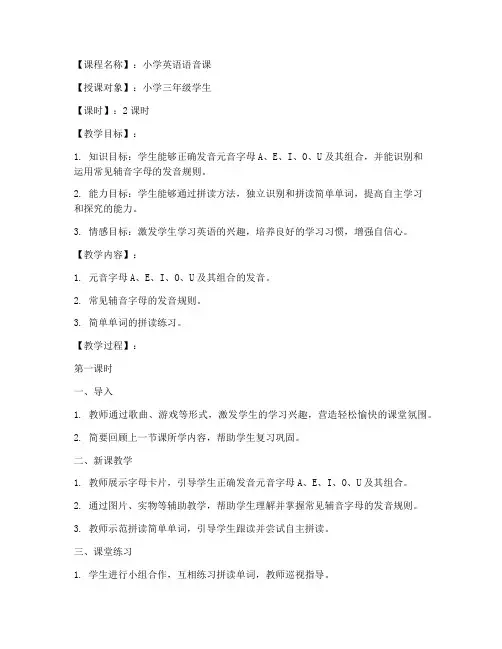
【课程名称】:小学英语语音课【授课对象】:小学三年级学生【课时】:2课时【教学目标】:1. 知识目标:学生能够正确发音元音字母A、E、I、O、U及其组合,并能识别和运用常见辅音字母的发音规则。
2. 能力目标:学生能够通过拼读方法,独立识别和拼读简单单词,提高自主学习和探究的能力。
3. 情感目标:激发学生学习英语的兴趣,培养良好的学习习惯,增强自信心。
【教学内容】:1. 元音字母A、E、I、O、U及其组合的发音。
2. 常见辅音字母的发音规则。
3. 简单单词的拼读练习。
【教学过程】:第一课时一、导入1. 教师通过歌曲、游戏等形式,激发学生的学习兴趣,营造轻松愉快的课堂氛围。
2. 简要回顾上一节课所学内容,帮助学生复习巩固。
二、新课教学1. 教师展示字母卡片,引导学生正确发音元音字母A、E、I、O、U及其组合。
2. 通过图片、实物等辅助教学,帮助学生理解并掌握常见辅音字母的发音规则。
3. 教师示范拼读简单单词,引导学生跟读并尝试自主拼读。
三、课堂练习1. 学生进行小组合作,互相练习拼读单词,教师巡视指导。
2. 教师组织单词接龙游戏,巩固学生对单词拼读的掌握。
四、总结与作业1. 教师总结本节课所学内容,强调重点和难点。
2. 布置课后作业,要求学生完成单词拼读练习。
第二课时一、复习1. 教师组织学生进行单词拼读接龙游戏,巩固学生对单词拼读的掌握。
2. 学生互相提问,复习上一节课所学内容。
二、新课教学1. 教师展示字母卡片,引导学生复习元音字母A、E、I、O、U及其组合的发音。
2. 教师通过图片、实物等辅助教学,帮助学生理解并掌握常见辅音字母的发音规则。
3. 教师示范拼读较难的单词,引导学生跟读并尝试自主拼读。
三、课堂练习1. 学生进行小组合作,互相练习拼读单词,教师巡视指导。
2. 教师组织学生进行单词拼读比赛,激发学生的学习积极性。
四、总结与作业1. 教师总结本节课所学内容,强调重点和难点。
2. 布置课后作业,要求学生完成单词拼读练习。
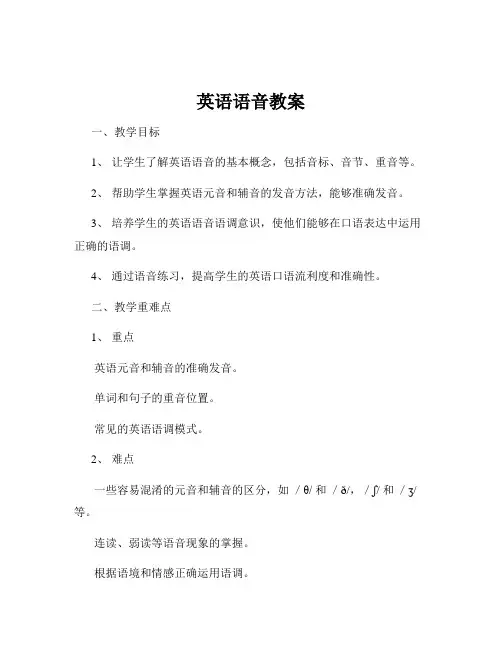
英语语音教案一、教学目标1、让学生了解英语语音的基本概念,包括音标、音节、重音等。
2、帮助学生掌握英语元音和辅音的发音方法,能够准确发音。
3、培养学生的英语语音语调意识,使他们能够在口语表达中运用正确的语调。
4、通过语音练习,提高学生的英语口语流利度和准确性。
二、教学重难点1、重点英语元音和辅音的准确发音。
单词和句子的重音位置。
常见的英语语调模式。
2、难点一些容易混淆的元音和辅音的区分,如/θ/ 和/ð/,/ʃ/ 和/ʒ/ 等。
连读、弱读等语音现象的掌握。
根据语境和情感正确运用语调。
三、教学方法1、讲授法讲解英语语音的基本概念和发音规则,让学生对语音知识有系统的了解。
2、示范法教师通过清晰、准确的发音示范,让学生模仿,直观地感受正确的发音方式。
3、练习法安排大量的发音练习,包括单个音素、单词、句子的练习,让学生在实践中巩固所学。
4、对比法对比容易混淆的音素,帮助学生找出差异,加深记忆。
5、多媒体辅助教学利用音频、视频等多媒体资源,丰富教学内容,增强学习的趣味性。
四、教学过程1、导入(5 分钟)通过播放一段英语原声电影片段或英语歌曲,引起学生对英语语音的兴趣,然后提问学生对英语语音的感受,引导学生思考语音在英语学习中的重要性。
2、知识讲解(20 分钟)介绍音标:展示音标表,讲解元音和辅音的分类和特点。
元音发音:逐个讲解元音的发音部位和方法,示范发音,让学生模仿练习。
辅音发音:同样的方式讲解辅音,重点强调容易出错的辅音。
音节和重音:解释音节的构成和重音的规则,通过单词示例让学生体会。
3、练习巩固(20 分钟)音素练习:教师发音,学生跟读,然后学生单独发音,教师纠正。
单词练习:给出一些包含所学音素的单词,让学生练习发音。
句子练习:朗读句子,注意单词的重音和句子的语调。
4、小组活动(15 分钟)将学生分成小组,进行对话练习,要求运用所学的语音知识,注意发音的准确性和语调的自然。
小组之间互相倾听、评价和纠正。
语音课教案英语语音课教学设计一、教学内容本节课选自《新编英语语音》教材的第二章,详细内容涵盖了元音音素及其分类,重点讲解短元音、长元音和双元音的发音要领,通过对比分析,帮助学生掌握不同元音音素的发音特点。
二、教学目标1. 了解元音音素的分类,能够准确描述各种元音音素的发音特点。
2. 掌握短元音、长元音和双元音的正确发音,并能运用到实际语境中。
三、教学难点与重点教学难点:短元音、长元音和双元音的发音要领,元音音素的区分。
教学重点:元音音素的发音技巧,语音辨识能力的培养。
四、教具与学具准备1. 教师准备:多媒体设备、PPT、录音机、磁带、卡片等。
2. 学生准备:课本、练习本、笔、录音机等。
五、教学过程1. 实践情景引入(5分钟)利用多媒体播放一段英语动画短片,让学生注意观察短片中人物的发音特点,引导学生关注元音音素。
2. 知识讲解(15分钟)(1)讲解元音音素的分类,对比分析各类元音音素的发音特点。
(2)通过举例,详细讲解短元音、长元音和双元音的发音要领。
3. 例题讲解(10分钟)(1)选取典型的例题,进行发音示范,让学生模仿练习。
(2)引导学生注意元音音素的发音细节,纠正发音错误。
4. 随堂练习(10分钟)(1)组织学生进行元音音素辨析练习,提高语音辨识能力。
(2)让学生分组进行角色扮演,模拟实际语境,练习发音。
(2)学生反馈学习情况,提出疑问,教师进行解答。
六、板书设计1. 板书元音音素发音技巧2. 板书内容:(1)元音音素分类(2)短元音、长元音和双元音发音要领(3)典型例题及答案七、作业设计1. 作业题目:(1)整理课堂笔记,归纳元音音素的发音特点。
(2)选取一段英语文章,标注其中的元音音素,并进行分类。
(3)录制一段自己的发音,与标准发音进行对比,找出差距。
2. 答案:(1)见课本第二章内容。
(2)文章中的元音音素分类见课本附录。
(3)标准发音见教材配套光盘。
八、课后反思及拓展延伸1. 反思:关注学生的发音细节,提高语音辨识能力,注重个体差异,因材施教。
课程名称:大学英语语音授课对象:大学英语一年级学生课时:2课时教学目标:1. 认知目标:使学生掌握英语音标的基本知识,了解英语语音的特点。
2. 功能目标:培养学生正确的发音方法,提高英语口语交流能力。
3. 意义目标:增强学生对英语语音学习的兴趣,提高英语学习的自信心。
教学重点:1. 英语音标的认读和拼读。
2. 英语语音的节奏和语调。
教学难点:1. 音标与音素的关系。
2. 语音的节奏和语调对口语表达的影响。
教学过程:第一课时一、导入1. 教师简要介绍英语语音在英语学习中的重要性,激发学生的学习兴趣。
2. 展示一段英语口语视频,让学生感受英语语音的美感。
二、讲解英语音标1. 介绍英语音标的分类(元音和辅音)。
2. 讲解元音音标和辅音音标的发音方法。
3. 通过图片、动画等形式展示音标的发音部位和发音方法。
三、练习1. 学生跟读音标,教师纠正发音。
2. 学生分组练习,互相纠正发音。
四、总结1. 教师总结本节课的学习内容,强调音标的重要性。
2. 学生分享学习心得,提出疑问。
第二课时一、复习1. 教师检查学生对音标的掌握情况。
2. 学生跟读音标,教师纠正发音。
二、讲解英语语音的节奏和语调1. 介绍英语语音的节奏和语调的特点。
2. 讲解如何通过调整语调来表达不同的语气和情感。
三、练习1. 学生跟读句子,教师纠正发音和语调。
2. 学生分组练习,互相纠正发音和语调。
四、角色扮演1. 学生分组进行角色扮演,运用所学语音知识进行对话。
2. 教师巡回指导,纠正发音和语调。
五、总结1. 教师总结本节课的学习内容,强调语音的节奏和语调对口语表达的重要性。
2. 学生分享学习心得,提出疑问。
教学反思:1. 本节课通过多种教学手段,使学生掌握了英语音标的基本知识和发音方法。
2. 在练习环节,教师应注重个别指导,帮助学生纠正发音错误。
3. 在角色扮演环节,教师应鼓励学生大胆开口,提高英语口语表达能力。
课后作业:1. 学生跟读教材中的句子,注意发音和语调。
《英语语音》课程教学教案一、教学内容本节课我们将学习《英语语音》教材的第三章“元音音素及其发音”,详细内容涉及长元音、短元音、双元音的发音规则及其在单词中的应用。
二、教学目标1. 学生能够掌握元音音素的发音要领,准确发音。
2. 学生能够辨别并运用元音音素在单词中的使用。
3. 学生通过语音练习,提高英语听说能力,增强语言感知。
三、教学难点与重点难点:元音音素的发音准确性,尤其是相似音素的区分。
重点:元音音素的发音规则以及在单词中的应用。
四、教具与学具准备1. 教师准备:PPT、录音机、教材、卡片。
2. 学生准备:教材、笔记本、彩色笔。
五、教学过程1. 实践情景引入(5分钟)教师播放一段英语动画片,让学生注意其中的元音音素发音。
2. 例题讲解(15分钟)教师通过PPT展示元音音素的发音口型、舌位等要点,并进行示范。
教师选取教材中的例词,引导学生跟读、模仿,纠正发音。
3. 随堂练习(10分钟)学生分组进行元音音素发音练习,相互纠正,共同进步。
教师挑选学生代表进行发音展示,给予评价与鼓励。
4. 应用实践(10分钟)教师设计一个简单的对话,让学生分角色进行朗读,注意元音音素的发音。
学生进行角色扮演,教师评价并指导。
学生分享学习心得,提出疑问,教师解答。
六、板书设计1. 《英语语音》第三章元音音素及其发音2. 内容:元音音素分类:长元音、短元音、双元音发音要领:口型、舌位、声带振动例词:[展示教材中的例词,标注元音音素]七、作业设计1. 作业题目:请运用本节课所学的元音音素,编写一段对话,不少于五行。
2. 答案示例:A: Hi, Tom! How was your vacation?B: It was great, thanks! I visited my grandma in the countryside.A: That's wonderful! Did you enjoy the fresh air?B: Yes, I did. I also helped her with farming.A: Sounds interesting! I hope to visit there someday.八、课后反思及拓展延伸1. 教师反思:关注学生的学习反馈,调整教学方法,提高元音音素教学的针对性和实效性。
课程名称:大学英语语音授课班级:大一英语班授课时间:2课时教学目标:1. 让学生掌握英语基本语音知识,包括元音、辅音、重音、语调等;2. 提高学生的英语听说能力,使他们能够正确发音、理解语音规律;3. 培养学生的语音语调意识,提高口语表达水平。
教学内容:1. 元音、辅音的发音及分类;2. 重音、连读、弱读等语音现象;3. 英语语调的基本规律;4. 语音练习及口语表达。
教学过程:一、导入(5分钟)1. 教师简要介绍语音课程的重要性,强调语音学习对提高英语听说能力的重要性;2. 提出本节课的学习目标,让学生明确学习方向。
二、元音、辅音的发音及分类(30分钟)1. 教师展示元音、辅音的发音口型图,讲解发音方法;2. 学生跟读练习,教师个别指导;3. 对比不同元音、辅音的发音特点,让学生掌握发音规律。
三、重音、连读、弱读等语音现象(30分钟)1. 教师讲解重音、连读、弱读等语音现象的概念及特点;2. 学生跟读练习,教师个别指导;3. 分析例句,让学生体会语音现象在实际语境中的应用。
四、英语语调的基本规律(15分钟)1. 教师讲解英语语调的基本规律,如降调、升调、升降调等;2. 学生跟读练习,教师个别指导;3. 分析例句,让学生体会语调在实际语境中的应用。
五、语音练习及口语表达(20分钟)1. 教师组织学生进行语音练习,如绕口令、歌曲、诗歌等;2. 学生分组进行口语表达,教师个别指导;3. 针对学生的发音、语调等问题,给予点评和建议。
教学评价:1. 课堂参与度:观察学生在课堂上的发言、练习情况,评价其参与度;2. 发音准确度:通过跟读、口语表达等形式,评价学生的发音准确性;3. 语调掌握程度:通过学生口语表达中的语调运用,评价其语调掌握程度。
教学反思:1. 教师应注重学生的发音、语调等语音现象的讲解,使学生掌握发音规律;2. 课堂练习应多样化,提高学生的学习兴趣;3. 注重个别指导,针对学生的发音、语调等问题给予针对性的指导和建议。
语音课教案英语语音课教学设计一、教学内容本节课为英语语音课,教学内容主要来自《新概念英语》第二册第19课 "The Greenhouse"。
本节课的教学重点为正确理解和使用英语中的连读现象,以及掌握相关词汇和短语。
二、教学目标1. 学生能够正确识别并模仿英语中的连读现象。
2. 学生能够理解和使用本节课的重点词汇和短语。
3. 学生能够在实际情景中运用所学知识进行流畅的对话。
三、教学难点与重点重点:正确理解和使用英语中的连读现象,以及掌握相关词汇和短语。
难点:连读现象的识别和模仿,以及相关词汇和短语的运用。
四、教具与学具准备教具:多媒体教学设备学具:笔记本、课本、练习册五、教学过程1. 导入:教师通过多媒体展示一些常见的连读现象,引导学生关注英语中的连读现象。
2. 讲解:教师详细讲解连读现象的定义、类型和规则,并通过例句和练习进行讲解和巩固。
3. 实践:学生分组进行练习,模仿和纠正连读现象。
教师巡回指导,并对学生的发音进行评价和反馈。
4. 应用:学生分成小组,根据所学的连读现象,编写一段对话。
教师对学生的对话进行评价和反馈。
六、板书设计板书内容:连读现象的定义、类型和规则。
七、作业设计1. 作业题目:请根据所学的连读现象,编写一段对话,并尽量使用本节课的重点词汇和短语。
A: Hey, B, how was your day?B: Oh, it was okay. I had a meeting this morning, and then I worked on the project.A: That sounds busy. Did you make any progress?B: Yes, I did. I finished the report and sent it to the boss.A: Great! I hope you get some good feedback.B: Me too. Anyway, how was your day?A: Yes, I did. I got an invitation to a conference next month.B: That's cool! I hope you have a great time.A: Thanks, B. I'm looking forward to it.1. I had a meeting this morning.2. I worked on the project.3. I finished the report and sent it to the boss.4. I hope you get some good feedback.5. I went for a run in the morning.7. I got an invitation to a conference next month.8. I hope you have a great time.9. I'm looking forward to it.八、课后反思及拓展延伸本节课通过讲解和练习,让学生了解了英语中的连读现象,并能够正确识别和模仿。
课程名称:英语语音教学教学目标:1. 学生能够正确识别和发音英语元音和辅音。
2. 学生能够运用所学发音技巧进行简单的单词和句子朗读。
3. 学生能够通过语音练习提高听力理解能力。
教学对象:初中一年级教学时间: 40分钟教学准备:1. 教学PPT或黑板2. 英语语音练习材料3. 音标卡片4. 录音机或多媒体设备教学步骤:一、导入(5分钟)1. 利用图片或视频引入与主题相关的英语单词,激发学生学习兴趣。
2. 简要介绍本节课的语音学习目标和重要性。
二、元音发音教学(15分钟)1. 展示音标卡片,介绍国际音标的基本概念。
2. 通过PPT或黑板展示元音字母在单词中的发音规则。
3. 逐个讲解和示范元音的发音方法,如/a:/, /i:/, /u:/, /ɔ:/, /e/, /æ/等。
4. 学生跟读练习,教师个别纠正发音。
三、辅音发音教学(15分钟)1. 介绍辅音的分类,如清辅音、浊辅音、摩擦音、爆破音等。
2. 通过PPT或黑板展示辅音的发音规则。
3. 逐个讲解和示范辅音的发音方法,如/p/, /t/, /k/, /b/, /d/, /g/, /f/, /θ/, /s/, /z/, /ʃ/, /ʒ/, /tʃ/, /dʒ/, /h/, /m/, /n/, /ŋ/, /l/, /r/, /w/, /j/等。
4. 学生跟读练习,教师个别纠正发音。
四、综合练习(10分钟)1. 学生分组,进行单词和句子的朗读练习。
2. 教师随机抽取学生进行发音展示,并进行点评和纠正。
3. 利用录音机或多媒体设备播放标准发音,让学生进行对比练习。
五、总结与作业(5分钟)1. 总结本节课所学的元音和辅音发音规则。
2. 布置课后作业,要求学生回家后进行语音练习,如朗读课文、听写单词等。
教学反思:1. 本节课的语音教学是否达到了预期的目标?2. 学生的发音练习是否足够?3. 教学方法是否需要调整以适应学生的需求?课后作业:1. 朗读并抄写今天学习的元音和辅音。
Supplementary Materials for Phonetics List of Phonetic SymbolsVowelsPure vowels1.Front v. /i:/ /i/ /e/ /æ /2.Central v. / ə:r/ / ər/ / ə/ /Λ/3.Back v. /a:/ /a:r/ /ɔ/ /ɔ:/ /ɔ:r/ /u/ /u:/Diphthongs /ei/ /ai/ / ɔi/ / əu/ /au/ /iə/ / iər/ / ɛər/ /uə/ Consonants1.Stops /p, b/ /t, d/ /k, g/2.Frictives /f, v/ /s, z/ /θ/-/ð/ /∫/-/Ʒ / /h/ /r/3.Affricatives /t∫/- /dƷ / /tr, dr/ /ts, ds/4.Nasals /m/ /n/ /ŋ /terals /l/ /l/6.Semi vowels /w/ /j/Front vowels /i:/ /i/ /e/ /æ /-/i:/----- key seat feel secret breathepolice machine prestige receipt-/i://i/-------- happy seed seat sitleague leak lickseized ceased cyst--------Tongue TwisterTim is as thin as a pin, but it isn’t a sin to be thin.-/e/------breath says said buryedge led sesame rebel (n.)---//---------sand land marry hatcap garage Stand up.--------Tongue TwisterJack’s black cat is catching a fa t rat.DialogueA: What’s the matter, Alice? You look so unhappy.B: I had a bad day yesterday.A: What happened?B: I went shopping and lost my bag.A: Your bag? Did you get it back?B: I went back for it. But it was already gone.A: That’s too bad. I’m sorry to hear it.Back vowels /a:/ /a:r/ /ɔ/ /ɔ:/ /ɔ:r/ /u/ /u:/-/a:/------calm palm Chicago moustache naïve-/a:r/------car cart card heart park hard large pardon hectare part-/æ /------When the letter “a ” appears in front of one ofthe following letters, it is pronounced as / æ /.-ss; -st; -sk; -th; -f; -lf; -m; -n; -gh/s/ /θ/ /f/ /m/ /n/glass-class-pass; fast-last-master-vast-past;ask-task-basket; path-bath; after-staff-draft;half-calf; command-demanddance-chance-advance-advantage-plant-aunt-branch-answer-can’t; laugh-draught--------Martin’s aunt is taking a sun-bath in the afternoon.The dance party in the farmyard lasted far into the night.After class, half of the students went out of the classroom.“You want to lose the chance?” the teacher asked.Time passes very fast.-/ɔ/-----cough because sausage Australiaknowledge sorry wander --- wonder- ------Lots and lots of clocks and watches are on sale in the shops. -/ɔ:/ -----all of us almost always also-/ɔ:r/------George had four daughters born in autumn.horse more door four morning-/u:/ /u/-----new duty Tuesday produce tomb-------- It’s Coo lAt noon I took a book,And sat by the pool near the school.I soon took off my shoe,And put my foot in the pool.Oh, how cool!A: George, what’re you gonna do tomorrow?B: John and I plan to play hockey in the morning.A: And in the afternoon?B: Well, after a long nap, we’ll go yachting with Monica.A: You’re sure to have a nice day tomorrow.B: What’re you gonna do?A: Lots of wok in the office and lots of chores at home. How I envy you, George.Central vowels / ə:r/ / ər/ / ə/ /Λ/-/ ə:r/--------desert-dessert-/ ər/----Saturday yesterday effort better-/ ə/ -----about again panda China sofaAustralia breakfast possible famous delicious campus-/Λ/------sun son country southern doubleblood does love courage cousintongue housewife muscle oven stomach--------I gave her some peals for her thirty-first birthday.Father and mother gathered the butter together.Martha doesn’t like to go to the cinema or the theatre. She prefers the concertHurry up! The sun has come up. Don’t touch the muddy duck.--------Tongue TwisterOnce upon a barren moorthere dwelt a bear, also a boar.The bear couldn’t bear the boar,the boar thought the bear a bore.At last, the bear could bear no morethat boar that bored him on the moor.And so one morn he bored the boar.That boar will bore the bear no more.Dialogue:A: Were you ever hurt in an accident?B: Yes, once. I hurt my head, and Igot a burn on my leg.A: Were you taken to the emergency room?B: Well, a person help me get there. Then the doctors and nurses were certainly concerned. So I survived.A: You were really lucky, weren’t you?Diphthongs/ei/ /ai/ / ɔi/ / əu/ /au/ /iə/ / iər/ / ɛər/ /uər/-/ei/-----halfpenny change steak ballet bouquet-/ai/ ------aisle isle height either neither minute diary-dairy- / ɔi/-----boy noise oil employ-/ əu/ go no-/au/-------down town brow frown bow house bowel doubt drough--------found----fond down----donpound----pond town----ton-/iə/-----idea theatre museum-/ iər/----hear here ear-/ɛər/ bear----beard----moustachepear----pearl----tear (n.)----tear (v.)----mayor-/uər/----touristPlosives/ Stops /p/- /b/ /t/- /d/ /k/ -/g/-/p/-----peak happy rapid-/b/-----spin Spain sport whisper respect--------captain top boy cheap cheese--------cap----cab mop----mob-----Tongue TwisterPeter Pepper picked up a peck of pickled peppers.Did Peter Pepper pick up a peck of pickled peppers?If Peter Pepper picked up a peck of pickled peppers,Where is the peck of pickled peppers Peter Pepper picked up.-/t/------too task tie-/d/-----steak stone start-football that day great joke Good morning!Water better butter Peter Betty fortyBetty bought a bit of better butter.But said she: “This butter is bitter.It’ll make my batter bitter.”Fricatives /f/ -/v/ /s/ -/z/ /θ/-/ð/ /∫/-/Ʒ / /r/ /h/--/f//v/------five view--------Forty fat farmers found a field of fine fresh fodder.Now, if the forty fat farmers found a field of fine fresh fodder,Where is the field of fine fresh fodder those forty fat farmers found. -/s//z/------seize-/θ//-ð /-----think thank thought these those--------Neither my mother nor my father likes this weather.-/∫/-/Ʒ /------she shell shore--------She sells seashells on the seashore,And the shells she sells ar e seashells, I’m sure.‘cause if she sells seashells on the seashore,The shells she sells are seashells for sure.-/r/-----spring scream for ever far away there is-----Robert Rolly rolled a round roll around.If Robert Rolly rolled a round roll around ,Where is the round roll Robert rolled around.Laterals /l/ /l/-/l/-------love glad only failure million sleep-/l/------feel girl help world almostNasals /m/ /n/ /ŋ /-/n/-------snow----slow now----loud----The next number is neither nine nor ninety-nine,but nine thousand nine hundred and ninety-nine.-/n/-/ŋ /-----sin----sing thin----thing son----song--singer singing sing a songThe Old Man is SnoringIt’s raining. It’s sin ging.The old man is snoring.He jumped into bed.And bumped his head,And couldn’t get up the next morning.Affricates /t∫/- /dƷ / /tr/-/dr/ /ts/-/ds/-/t∫/------China cheap choice choose chose chosen-/dƷ /------Our Joe wants to know if your Joewill lend our Joe your Joe’s banjo.If your Joe won’t lend our Joe your Joe’s banjo,Our Joe won’t lend your Joeour Joe’s banjo when our Joe has a banjo.Jack watched George eat a peach on the bridge near the church.-/tr/--/dr/-----track try entry poetry street---The tracker tracked and tricked and trapped the tricky trickster.半元音/w/ /hw/ /j/-/w/ what where why when-/j/ year/ear| ɔs’treil jə| | əpə’t ju:niti| | ‘t∫ɔpstiks | | lΛg’zuəriəs || ‘hændsəm | | ə’kauntənt | | dƷi’ɔmitrikəl | | pres’ti:Ʒ| | kæfi’tiəriə| |dis’trɔi /--------c.+ /n//t/ cotton written certainly/d/ pardon garden suddenly/s/ lesson listen person/z/ season prison/v/ seven eleven seventy/f/ oftenc+/l/little/ capital----schedule lieutenant clerk textile missile epoch leisure hurry ate advertisement anti- address record either neither tomato magazine researchStressWord Stresssometimes bamboo produce homelanddecide goldsmith rehearsal timetablewell-known cafeteria Arabic calligraphynecessity afternoon grandchild occasionalindividually everyday disagreeable geometricalappropriate rectangular abbreviation diameterreceipt longevity approximate mooncakeSentence Stress1. We made the same mistakes on the test2. ------ That’s my sweater.------Oh no, it isn’t. It’s my sweater.3. ------Would you like me to write the letter?------No. I want him to write it.4.------Is Colin happy in his job?------No. He is going to move.------What’s Colin going to do?------He’s going to move.------Did you say Colin had moved?------No. He’ going to move.5.------When is Peter’s birthda y?------It’s on the twenty-first.------Is Peter’ birthday on the thirty-first?------No. It’s on the twenty-first.------Did you say Peter’s birthday was on the twenty-fourth?------No. It’s on the twenty-first.English Songs1. Silent Night, Holy NightSilent night, holy night,All is calm, all is bright.Round your virgin mother and child,Holy infant, so tender and mild,Sleeping heavenly peace.Sleeping heavenly peace.2. Auld Lang SyneShould all acquaintance be forgot,And never brought to mind?Should all acquaintance be forgot,And days of auld lang syne?For auld lang syne, my dear,For auld lang syne.We’ll take a cup of kindness yetFor auld lang syne.3. EdelweissEdelweiss, edelweiss.Every morning you greet me.Small and white, clean and bright,You look happy to meet me.Blossom of snow may you bloom and grow, Bloom and grow for ever.Edelweiss, edelweiss,Bless my homeland forever.4. Do-Re-MeLet’s start at the very beginning,A very good place to start.When you read you begin with A B C, When you sing you begin with Do Re Mi, Do Re Mi, Do Re Mi,The first three notes just happen to be.Do Re Mi, Do Re Mi,Do Re Mi Fa So La Ti,Doe, a deer, a female deer,Ray, a drop of golden sun,Me, a name I call myself,Far, a long, long way to run,Sew, a needle pulling thread,La, a note to follow “Sew”,Tea, a drink with jam and bread.That’ll bring us back to Do, Do, Do,Do Re Mi Fa So La Ti Do So Do.5. Jingle BellsDashing through the snow,In a one-horse open sleigh,Over the fields we go,Laughing all the way;Bells on bobtail ring,Making spirits bright,What fun it’s to ride and singA sleighing song tonight!Jingle bells, jingle bells,Jingle all the way!Oh! What fun it’s to ride in aOne-horse open sleigh!Jingle bells, Jingle bells,Jingle all the way!Oh! What fun it’s to ride in a one-horse open sleigh.6. Old Black JoeGone are the days when my heart was young and gay; Gone are my friends from the cotton fields away;Gone from the earth to a better land I know,I hear their g entle voices calling, “Old Black Joe”.I’m coming, I’m coming,For my head is bending low.I hear their gentle voices calling, “Old Black Joe”.7. Oh, No, JohnOn yonder hill there stands a creature,Who she is I don’t know;I shall go and court her for her beauty,She must answer yes or no,Oh, no, John, no, John, no, John, no!My father was a Spanish captain,Went to sea a month ago;First he kissed me, then he left me,Bid me always answer “No”.Oh, no, John, no John, no, John, no!8. Five Hundred MilesIf you miss the train I’m on,You will know that I am gone.You can hear the whistle blows a hundred miles.A hundred miles, a hundred miles, a hundred miles, a ……You can hear the whistle blows a hundred miles.Lord, I’m one. Lord, I’m two.Lord, I’m three, Lord, I’m four.Lord, I’m five hundred miles away from home.Away from home, away from home,Away from home, away from home.Lord, I’m five hundred miles away from home.Not a shirt on my back.Not a penny to my name.Lord, I’m five hundred miles away from home. Away from home, away from homeAway from home, away from home.Lord, I’m five hundred miles away from home.8. Home on the RangeOh, give me a home where the buffalo roam, Where the deer and the antelope play,Where seldom is heard a discouraging word, And the skies are not cloudy all day.Home, home on the range,Where the deer and the antelope play,Where seldom is heard a discouraging word, And the skies are not cloudy all day.9. Long Long AgoTell me the tales that to me were so dear. Long long ago, long long ago.Sing me the songs I delighted to hear.Long long ago, long ago.Now you’ve come, my grief is gone.Let me forget how love has won.Let me believe that you love as you loved. Long long ago, long ago.Long long ago, long ago.10. My Bonnie is Over the OceanMy Bonnie is over the ocean.My Bonnie is over the sea.My Bonnie is over the ocean.Oh, bring back my Bonnie to me.Bring back, bring back.Oh, bring back my Bonnie to me, to me. Bring back, bring back.Oh, bring back my Bonnie to me.11. You are My SunshineThe other night, dear, as I lay sleeping.I dreamed I held you in my arms.When I awoke, dear, I was mistaken.And I hung my head and cried.You are my sunshine, my only sunshine.You make me happy when skies are gray.You’ll never know, dear, how much I love you.Please don’t take my sunshine away.You told me once, dear, you really loved me.And no one else could come between.But now you’ve left me and love another,Yes, you’ve shattered all my dreams12. Yesterday Once MoreWhen I was young I’d listen to the radio,waiting for my favorite songs.When they played I’d sing along,It made me smileThose were such happy time and not so long ago,How I wondered where they’d gone,But they’re back againJust like a long lost friend.All the songs I love so well.Every sha-la-la-la every wo wo still shine.Every shing-a-ling-a-lingThat they’re starting to sing so fine.When they get to the part,Where he’s breaking her heart,It can really make me cry,Just like before.It’s yesterday once more.13. She’ll be Come in Around the MountainShe’ll be come in around the mountain when she comes. She’ll be come in around the mountain when she comes. She’ll be come in around the mountain,----------------When she comes.Short PlaysFly SoupCharacters:Henry Smith (S); a waiter (W); customer 1,2,3(C1, C2, C3); the restaurant manager(M)Scene: a crowded New York restaurantS: Waiter! Waiter!W: Yes?S: There’s a fly in my soup.W: But that’s impossible.S: Look!W: Where?S: There. What’s that?W: What?S: That little black speck of wet wings. What’s that?W: Black paper. It’s black paper.S: It is not black paper. It’s a fly.C1: What’s wrong?C2: What’s the matter?C3: What is it?S: There’s a fly in my soup.W: He says th ere’s a fly in his soup.C1: Where is it?C2: Let me see.S: There!C3: Yes. That’s a fly.W: No, it isn’t.S: Yes, it is.W: No, it isn’t.M: What’s going on here?W: This man says there’s a fly in his soup.M: There’s a fly in his soup in my restaurant?That’s impossible.S: Here, what’s this? Is this a fly or not?M: Shea! Please, Mr. Shea! Waiter, bring us steak dinner.S: Well, maybe, bring us steak dinner and wine and pie and coffee.C1: What’s that?C2: What?C1: This.C2, C3: What is it?C1: it’s a box of flies.M: Get out of my restaurant. Get out!Tongue Twister1.A big black bug bit a big black bear made the big black bear bleed blood.Good morning blackboard2.Peter Pepper picked up a peck of pickled peppers.Did Peter Pepper pick up a peck of pickled peppers?If Peter Pepper picked up a peck of pickled peppers,Where is the peck of pickled peppers Peter Pepper picked up.3.Forty fat farmers found a field of fine fresh fodder.Now, if the forty fat farmers found a field of fine fresh fodder,Where is the field of fine fresh fodder those forty fat farmers found.4.She sells seashells on the seashore.The shells she sells are seashells, I’m sure.‘cause if she sells seashells on the seashore,the shells she sells are seashells for sure.5.Robert Rolly rolled a round roll around.If Robert Rolly rolled a round roll around,Where is the round roll Robert rolled around.Exercises for rhythm1.One, Two, Three, Four, fiveOne two three four five,Once I caught a fish alive.Six seven eight nine ten,then I let it go again.Why did you let it go?‘cause it bit my finger so.Which finger did it bite?This little finger on the right.1.Swift the Moment Flies Away.Swift the moment flies away.First the hours and then the day.Next the week the month the year,Go away and disappear.2.In the Merry Month of MayIn the merry month of May,All the little birds are gay.They all hop, land, sing and say,The winter days are far away.Welcome, welcome the merry may.3.Four seasonsSpring is gay with flower and songSummer is hot and days are long.Autumn is rich with fruit and grain,Winter brings snow and the New Year again.4.The Snow ManWe built a snow man nice and whiteAnd decorated him very bright,With a big top hat and a carrot nose,And a scarf as red a full-bloomed rose.This snow man came alive one day.And we did laugh and dance and play.By our fireplace he knelt,And too soon, our snow man did melt.5.DreamsHold fast to dreamsFor if dreams dieLife is a broken-winged birdThat cannot fly.Hold fast to dreamsFor when dreams goLife is a barren fieldFrozen with snow.6.I breathed a song into the air,it fell to earth I knew not where.for who has sight so keen and strong,that it can follow the flight of songs.7.Two Little DragonsTwo little dragons lived in a wood.One was bad one was good.One went walking straight to school.One went fishing in Cranberry pool.One learned add-up and takeaway.One spent all his time in play.One helped mother when school was done,One chased little boys just for fun.If you were a dragon and lived in a wood,Would you be bad or would you be good?Topics for discussion1. Talk with you partner about your personal preference for weather.2. Ask you friend to help you with your English studies3. Buying shoes in a shoe shop, talking with the shop assistant.talk with your partner about what you think you’ll be doing in the winter vocation.4. Discuss with your partner what are the advantages and disadvantages of having a phone, give your own opinions.6.Make a dinner date with your friend on the phone.语音练习 jazz chants1. Sh! Sh! Baby's sleeping !Presentation notes: I usually introduce this chants by asking the students what they say when Someone is making too much noise.I write their answers on the blac kboard, including Sh, Hush Please be quite and shut up, explaining the reason we are asking for silence is that the baby's sleeping.I said,Sh! Sh! Baby's sleeping!I said , Sh! Sh! Baby's sleeping!What did you say?What did you say ?I said Sh! Sh! Baby's sleeping!I said, Sh! Sh! Baby's sleeping!What did you say?What did you say ?I said,Please be quite,Baby's sleeping!I said,Please be quite,Baby's sleeping!What did you say?What did you say?What did you say?I said , Shut up! Shut up! Baby's sleeping !I said, Shut up! Shut up !Baby's sleeping !WAAAAAAAAAAAAAAAAAAAAEasterEaster Sunday is a Christian festival commemorating the Resurrection of Christ. It is in spring, usually in April. The idea of the egg as a symbol of new life was adopted to symbolize the Resurrection. Easter is a joyful church holiday, and many churches have an outdoor service at sunrise on this day. Children and their parents color hard-boiled eggs before Easter. Late Saturday night or early Sunday morning the eggs are hidden, and the children have an Easter egg hunt Sunday. Usually little candies and perhaps a large chocolate egg are hidden along with real eggs. Little children believe the Easter rabbit comes and leaves the eggs for them. By this time of the year, winter is over and the weather is getting warmer. Many people buy new spring clothes and wear them for the first time on Easter Sunday.Most of us like to eat potatoes. But most people do not know what part of the potato is best for food. Take a sharp knife and cut from the middle of the potato a slice as thin as paper. Hold the slice between your eyes and the light. You will see that the potato has a skin, an outside rim, and an inside part. The outside rim which is immediately beneath the skin of the potato is the most valuable part of all. This is often thrown away with the skin. Even the skin itself is better for food than the inside. When eating a baked potato, if you scoop out the inside and leave the outside, you are wasting the best of it. If you cannot eat the whole potato, eat the outside and leave the inside.Verse-reading:London Bridge is falling down,Falling down, falling down.London Bridge is falling down,My fair lady.Exercises for Incomplete Plosion, Nasal and Lateral plosion1.Incomplete plosionblackboard, great concern, friendship first, a one-sided viewconstant vigilance, a complete victory, abstract theory,a public show, white chalk, excellent judgement2.Nasal Plosion/t,d+m,n/ good morning, attend meetings, midnight, good newsAn important matter, don’t knowteral Plosion/t,d+l/ little, battle,bottlehandle, candle, middleboldly, friendly, loudlyat least, at last,at lunchan outline, the third lessonExercises for Linking1.Consonant +VowelGood idea/ read it again/ an hour/ in an hour/ in August/ in an instant/ let him in/ back in a minute/ a bottle of ink/ a bowl of rice/ above all/ take it off 2.R-linkingThere is/ our own/ far away/ father and mother/ for instance3.Vowel+vowel/i/ I am/ try again/ stay up/u/ go out/ go on/ throw awayExercises for Weak Formsa an /ə, ən / a table/ an ugly man/ an honest girlam / əm, m / I’m all right./ I’m in a terrible hurry.and / ənd, ən / John and Kate left early.Are /ə / The boys are here.Can /kən/ What can I do to help you.Been /bin/ All the work’s been done.He /hi, i/ He told me a story./ What was it he said?Ice-breaking Team Activity: Say it in Different MoodYour team has 10 minutes to practice the following sentences according to the instructions in brackets.Your team has 2 sentences to perform. When performing, your team has to face the audience and say the 2 sentences picked by the host of the game.Criteria1.Able to present the sentence in the right mood as instructed.2.Good pronunciation and intonation.3.Good-cooperation---members being active to perform and teaam spirit shown.4.Able to finish performance within the set time(30 seconds)Score5 marks good performance3 marks average performance1 marks improvement much neededSentences1.The missing animals is found in the rainforest.(secretly)2.The missing animals is found in the rainforest.(surprisingly)3.The missing animals is found in the rainforest.(announcing good news to thepublic)4.Don’t move! Or you’ll die.(whispering to your friends when you two are hiding)5.Don’t move! Or you’ll die.(shouting to warn your friend of the danger)6.Don’t move! Or you’ll die.(threatening the victim)7.What a good suggestion you make! (with appreciation)8.What a good suggestion you make! mockingly)9.Oh my goodness! Susan has broken the record!。